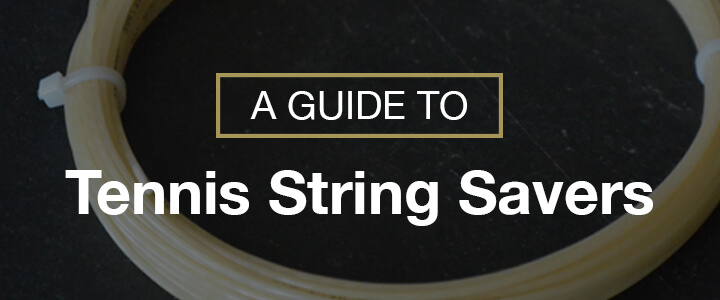Check out my custom vibration dampener
A Guide to Tennis String Savers
Including Our Favorites
We hope you love this article. Just so you know, TennisCompanion may collect a small share of sales from the links on this page to help keep this site running. Learn more.
Have you ever seen a close-up shot of a professional’s racket and wondered what the tiny dots are between the strings? It’s not an illusion. Those are string savers, devices players use for a number of reasons.
Obviously they can help prolong the life of your strings, but for some players, that’s not all. Take a read through our guide to find all the ways you can benefit from this nifty invention.
Here’s a quick look at what we’ll cover – click any of the links below to jump straight to that section:
If you’re interested in trying them out yourself, here are our picks for the best on the market. Keep reading to learn more about why these two are our favorite.
| Rank | Best String Savers |
| #1 | Babolat ElastoCross |
| #2 | Tourna Cross |
| n/a | Tourna Cross Refills |
Article Contents
Click below to jump to a section
Tap below to jump to a section
What Are String Savers?
Are String Savers Legal?
String Savers & Performance
How to Use String Savers
String Savers & The Pros
String Saver Guide
Best String Savers
Wrapping Up
New to TennisCompanion?
Create a free account and explore my latest videos below
What Are String Savers?
String savers are devices used to preserve racket strings and extend their life. They’re small pieces of plastic or similar material that are placed where the cross and main strings intersect.
When the strings of your racket strike the ball, they rub together. This friction wears them down and can eventually cause them to break. A string saver acts as a buffer between the two strings.
You can put string savers at any string intersection, but players usually install them in high-wear areas. Frequently toward the center of the racket where the strings connect with the ball.
If you’ve had strings break repeatedly in a specific spot or noticed a lot of wear at certain intersections, that’s probably a good place to use string savers.
Are String Savers Legal?
String savers are perfectly legal for use in competitive play per the International Tennis Federation and the official rules of tennis. Rule 4 in the ITF Rulebook refers us to Appendix II B which states the following:
“The hitting surface of the racket shall be flat and consist of a pattern of crossed strings connected to a frame and alternately interlaced or bonded where they cross.”
String savers simply don’t have a material impact and therefore are legal for use.
How Do String Savers Affect Your Game?
Adding something between your strings, especially if it’s designed to interfere with natural string movement, is going to affect the performance of your racket.
Some players claim they can actually feel a difference when they hit the ball, while others don’t notice a huge difference. Either way, here are a few ways you may experience string savers impacting your game.
Feel
The most obvious change most players tend to notice is a deadening of the string bed, similar to the feel you might experience when using a vibration dampener. If you don’t use a vibration dampener, you may perceive a slight decrease in playability or feel. On the other hand, you may find it harder to detect a change in feel if you’re already using a vibration dampener.
Spin
The jury is out here, but string savers should theoretically decrease topspin because they limit the snap-back effect of the strings after a ball is struck, which helps produce topspin.
However, some professionals like Roger Federer claim they actually increase spin because he feels they provide more grip and therefore rotation of the ball. When I’ve used them, I begin to notice more of a difference the more of them that I install. Typically, I limit the number that I use to ten or so and the impact is negligible.
My recommendation is to experiment with them yourself and form your own opinion. Depending on how many you use and how heavily you rely on topspin may be a factor in whether you notice much difference.
Tension
When string savers are installed, they increase the tension of your strings slightly and therefore all things equal decrease power potential and increase control. This is worth keeping in mind when you use them.
If you want to limit the change in tension you might consider a slight drop of a pound or two when you get your racquet strung next time. Also, keep in mind that the more string savers you install the greater the difference in tension.
How to Use String Savers
Ultimately, how you use string savers is up to you. However, the most common reason players will install them is to get more life out of their strings and in the process save some cash.
If you’re thinking about using string savers, you’ll want to use them all the time. As mentioned, they can change the performance of your racquet, so you’ll want to get used to them.
Where should you install them?
Pay attention to where your strings are breaking. That’s probably near the center or sweet spot of your racquet where you hit the ball most and where your strings need more protection.
If you’re still new to the game and haven’t had the pleasure of breaking a string, look closely at the intersections. You’ll see little notches on the strings where they’ve rubbed against each other. Find the places with the most wear and consider that location for using string savers in the future.
How do you install string savers?
String savers are really small, so they can be tricky to manipulate at first. Luckily, most string-saver brands come with an applicator.
The applicator acts as a lever and lets you separate the cross from the main. Then you slide one of the string savers into the intersection. Once you release the applicator, the tension from the strings holds the string saver in place.
What pattern should you use?
Some players like Roger Federer prefer an alternating pattern when installing string savers. It’s a personal preference, but I like that approach because it uses fewer of them and in my experience has less of an impact on racquet performance. In essence, when I use string savers I’m looking to protect my strings without dramatically altering how my racquet plays.
Again, this is where I’d encourage you to experiment so you can determine what works best for you.
String Savers and The Pros
If you doubt the value of string savers, consider their use by some of the top pros on tour.
Roger Federer
Federer is the player whose string-saver use is most well known. He uses ten string savers in a crisscross pattern toward the upper end of his racquet’s sweet spot. Likely where he’s experienced the most wear in the past.
Check out his racquet at 0:20 seconds in the video below. He certainly makes a case for evaluating strings savers yourself.
Grigor Dimitrov
Dimitrov’s style of play has often been compared to that of Federer and it turns out the similarities don’t stop there–he also happens to use string savers.
If you look closely at a photo or video of his racquet, you can see the string savers installed in a pattern similar to Federer’s.
Pete Sampras
Although retired, Sampras is another player well known for using string savers and even installing them while playing in between points.
He used natural gut strings, which he believed played better when they were worn almost to the point of breaking. With string savers, he was able to extend the life of his strings to help maximize performance.
String Saver Guide
To choose our top picks, we kept a few simple factors in mind. There isn’t a wide range of availability of strings savers on the market, but the products we decided on all excel in these areas and are overall great purchases.
Materials
String savers are meant to increase the life of your strings, so they should hold up to wear and tear themselves. When we chose our top picks, we looked for products made from durable material that would last.
They’re almost always made of a plastic or composite, but many manufacturers have their own proprietary materials that vary in quality. You can be sure our favorites will get the job done.
Ease of use
Without an applicator, installing string savers would be a nightmare. They’re tiny, and strings are tight. Luckily, applicators make it a relatively painless process once you get the hang of it.
Not all applicators are created equally, though. Some are a little easier to handle and more self-explanatory when it comes to installation. When selecting our top picks, we looked for string savers with good applicators that make installation a breeze.
Price
One of the main reasons players invest in string savers is to save money on restringing, so they shouldn’t be too expensive themselves. We made sure to pick string savers that were a great value.
The Best String Savers
Here are our top picks for string savers.
Babolat ElastoCross Tennis String Saver

Babolat claims their string savers increase the life of your strings by up to 50%. It’s that toughness that earns them a spot on our list.
They’re made of a strong plastic that effectively cuts down on the friction between the strings. If you use gut or multifilament strings, they’ll get you a lot more life and keep you from restringing–and dropping extra money on new strings–every few matches.
Babolat’s string savers are easy to install, too. They come with an applicator tool that employs hooks to lift up the strings and hold them open. These keep the strings from snapping off the applicator, wasting time and leaving you frustrated.
Finally, they’re a great value. For a low price, you can significantly increase the life of your strings, especially gut if you’re lucky enough to play with this high-end string. When you consider how much money it is replacing strings over and over, these string savers are a smart investment.
Tourna Cross String Savers

Pete Sampras used these on his racket when he won 14 Grand Slams. Like Pete Sampras, you can use these to take your strings to the edge of their lives and beyond. They lock strings in place to keep them from rubbing against each other when you hit the ball.
They’re small pieces of plastic that come in a rounded design that does a great job at reducing string movement. You’ll notice when you install them that they mold to the strings under pressure.
The applicator uses hooks to hold up the strings. Then you slide one of the string savers down into place. They go in easily, so installation only takes a few seconds.
The Tourna Cross string savers really take the gold when it comes to price. As one of the least expensive products on our list, you more than get a bang for your buck. Take a look at these string savers if price is your top concern.
Wilson Friction Fighter

These are the string savers of choice used by Roger Federer. Unfortunately, they’re not easy to find these days and may even have been discontinued for public use.
The Friction Fighters are shaped similar to the Babolat ElastoCross string savers. They’re also made of the same strong material that prevents friction where the strings intersect.
The applicator Wilson made for these string savers works great. It’s shaped with a bulge at the end, so it won’t slip out of your hand. You can just slide the string savers in, and you’re ready to play.
If you can find them, they also come at a great price.
Wilson String Glide

Wilson’s String Glide string savers look a little different than other models but don’t let that fool you. They’re still great at cutting down the friction between strings so you don’t get as many breaks.
These string savers are small round disks. As the name suggests, this shape provides a gliding, low-friction surface that saves strings from wear and tear. As an added bonus, you also get a long life out of the string savers themselves thanks to the smooth design.
The applicator is similar to that of other brands. The round string savers don’t line up like others, though, so they move freely inside the tool. You can easily move them into the insertion point with your finger and then insert them using the lever of the tool.
Like Wilson’s other model, String Glide string savers are a name-brand product at a great value. However, these string savers are just as hard to find as Wilson’s String Glide these days.
If you like experimenting with your gear, these are a great product to check out.
Discontinued: String-A-Lings
String-A-Lings were one of the original string-saver brands, but they’ve been discontinued. They were simple and well made, designed to reduce friction and help keep your strings fresh.
The tool that came with these string savers was different than those available for players these days. The string savers didn’t actually go inside the applicator. Instead, they came separately, and the tool was a small lever you could use to lift up the strings. This gave you control over the string saver as you set it in the intersection with your fingers.
While they’re no longer available for purchase, they’re still frequently referenced and searched for online.
Should You Start Using String Savers?
If you’re using natural gut, then string savers can serve as a great investment. Not only are gut strings more expensive, but they’re prone to breakage.
If you use a multifilament, string savers can also be a good choice to cut down on the fraying that is common. If you’re curious it’s a relatively low-cost experiment to see if you can prolong the life of your strings and save money over the long haul.
Play Better Tennis
Improve your game alongside our community of tennis players
Why join?
Discussion Boards
Join the conversation with other members of the community.
5 Point Friday
Read our weekly recap of the 5 most interesting things we dig up in tennis.



Leave a Reply
Want to join the discussion?Feel free to contribute!